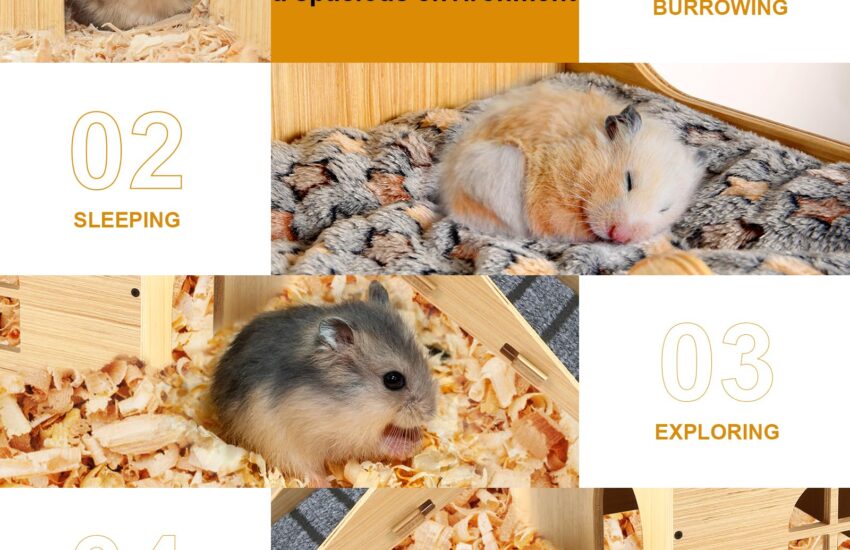Exploring Common Hamster Types
Hamsters have become increasingly popular pets due to their small size, gentle demeanor, and relatively low maintenance needs. In this article, we will explore various types of hamsters, highlighting their unique characteristics, habitat preferences, and care requirements. Let’s dive into the delightful world of these furry companions!
Popular Types of Hamsters
When considering a hamster as a pet, it’s essential to understand the differences between the species. Some species are more suitable for children, while others have specific care requirements. The following sections will introduce you to the most common hamsters and the reasons for their popularity.
Syrian Hamsters
Among the most well-known types, **Syrian hamsters** can be quite social and human-friendly. These hamsters are also referred to as golden hamsters due to their golden-brown fur. They typically measure 5 to 7 inches long and thrive alone. Unlike some other types of hamsters, they are territorial and can become aggressive if housed with other hamsters. A well-equipped cage with hideouts and gnawing toys will keep them entertained. To give you a better visual understanding, here’s a glimpse of a Syrian hamster:

Dwarf Hamsters
**Dwarf hamsters** are smaller than Syrian hamsters and are classified into several species, including Campbell’s, Winter White, and Roborovski. Campbell’s dwarf hamsters are generally friendly and often enjoy socializing, while Winter Whites are slightly more reserved. Roborovski hamsters are known to be the most active and playful, making them fun pets to observe. Regardless of the species, dwarf hamsters can live together if introduced properly, as they are less aggressive than their larger counterparts.

Chinese Hamsters
**Chinese hamsters** are unique due to their long tails and dark brown fur, often mixed with lighter shades. They are slightly larger than dwarf species, growing up to 4-5 inches. These hamsters are known for their inquisitive and agile nature. Proper interaction is required to make them more social; otherwise, they may become skittish when handled. A secure cage with plenty of enrichment activities will keep them active and healthy.
Care and Habitat Needs
Understanding the care needs and habitat preferences of various hamster types is crucial for their well-being. These factors include dietary needs, cage setup, and socialization tips, ensuring your hamster thrives in its home environment.
Cage Setup
The cage is a hamster’s sanctuary, and it must be designed according to the species’ preferences. Syrian hamsters require cages that are at least 24 inches long with ample vertical space for climbing; they enjoy tunnels and platforms. In contrast, dwarf hamsters do well in slightly smaller cages but still appreciate a multi-level setup. Regardless of the type, it’s essential to provide bedding, hiding places, chewing toys, and a secure environment to prevent escapes.
Feeding and Nutrition
A well-balanced diet is vital for a hamster’s health. Most hamsters primarily eat a commercial pellet food specifically formulated for hamsters, supplemented with fresh fruits and vegetables in moderation. For example, carrots, broccoli, and small pieces of apple can be safe treats. Always avoid feeding them sugary or acidic foods as they can cause health issues. Regularly provide fresh water to keep them hydrated.
Socialization and Handling
Each hamster type has its approach to socialization and handling. Syrian hamsters thrive on human interaction, making them excellent choices for families with older children. Meanwhile, dwarf and Chinese hamsters require gentle handling and socialization to develop trust. Always approach them quietly and allow them to explore without feeling threatened. Positive reinforcement through treats can encourage friendly behavior.
Health and Wellness
Monitoring your hamster’s health is essential for ensuring a long and happy life. Knowing common health concerns for each species and recognizing behavioral changes will help in providing timely care.
Common Health Issues
Some frequent health concerns among hamsters include wet tail, dental issues, and respiratory infections. **Wet tail**, especially prevalent in young hamsters, is a serious condition that requires immediate veterinary attention. Regularly checking their teeth and providing chew toys can help prevent dental problems. Additionally, keeping their habitat clean will reduce the risk of infections. It’s crucial to stay vigilant and consult with a veterinarian if you notice any abnormal behaviors.
Regular Vet Checkups
Just like other pets, hamsters should have routine veterinary visits to monitor their health. Ensure your vet is knowledgeable about small pets to provide the best possible care. Your veterinarian can help identify potential issues early, ensuring that your hamster leads a healthy life. Additionally, regular checkups allow for vaccinations or treatments specific to your hamster’s needs—a necessary step toward responsible pet ownership.
Conclusion
Hamsters make delightful pets, offering companionship and joy with their unique personalities. Understanding the differences between the various types of hamsters, their care requirements, and potential health issues is essential for ensuring that these furry friends thrive. By providing a suitable environment, proper nutrition, and regular handling, you can foster a loving relationship with your hamster.
FAQ
1. Do hamsters prefer to live alone or in groups?
Most **hamster types** prefer solitary living, particularly Syrian hamsters, which can become aggressive toward others. However, certain dwarf hamsters can live in pairs or small groups if introduced correctly. Ensure you research your specific hamster type to understand its social needs better.
2. Can I feed my hamster fruits and vegetables?
Yes, but only in moderation. Small amounts of fruits and vegetables can provide valuable nutrients and enrichment. Be cautious about what you offer, avoiding high-sugar items and those that might upset their digestive systems.
3. How often should I clean my hamster’s cage?
A thorough cleaning should be performed once a week, with spot cleaning done every few days to maintain hygiene. Regular cleaning helps keep your hamster healthy and comfortable and also prevents odors.
4. What is the average lifespan of a hamster?
Hamsters typically live for 2 to 3 years, although this can vary by type. Syrian hamsters tend to live slightly longer than dwarf and Chinese varieties. Providing excellent care and monitoring their health can help extend their lifespan.
5. How can I tell if my hamster is unwell?
Signs of an unwell hamster can include changes in eating habits, lethargy, excessive grooming, or unusual sounds when breathing. Keeping a close eye on your hamster’s behavior and consulting with a vet promptly when concerns arise is vital.
Key Takeaways:
– Various hamster types, including Syrian, dwarf, and Chinese, have distinct characteristics.
– Carefully setup their habitat and maintain their nutrition for optimal health.
– Regular vet checkups and observing signs of illness are crucial to hamster care.
Feel free to engage with this post by sharing your experiences with different hamster types, or reach out for additional tips on hamster care!
